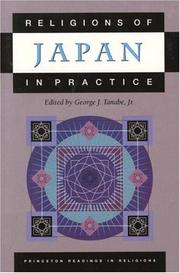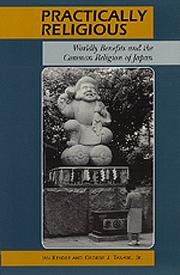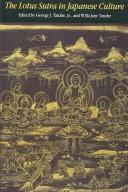| Listing 1 - 3 of 3 |
Sort by
|

ISBN: 0691057885 0691057893 0691214743 9780691057880 Year: 1999 Publisher: Princeton Princeton university press
Abstract | Keywords | Export | Availability | Bookmark
 Loading...
Loading...Choose an application
- Reference Manager
- EndNote
- RefWorks (Direct export to RefWorks)
This anthology reflects a range of Japanese religions in their complex, sometimes conflicting, diversity. In the tradition of the Princeton Readings in Religions series, the collection presents documents (legends and miracle tales, hagiographies, ritual prayers and ceremonies, sermons, reform treatises, doctrinal tracts, historical and ethnographic writings), most of which have been translated for the first time here, that serve to illuminate the mosaic of Japanese religions in practice. George Tanabe provides a lucid introduction to the "patterned confusion" of Japan's religious practices. He has ordered the anthology's forty-five readings under the categories of "Ethical Practices," "Ritual Practices," and "Institutional Practices," moving beyond the traditional classifications of chronology, religious traditions (Shinto, Confucianism, Buddhism, etc.), and sects, and illuminating the actual orientation of people who engage in religious practices. Within the anthology's three broad categories, subdivisions address the topics of social values, clerical and lay precepts, gods, spirits, rituals of realization, faith, court and emperor, sectarian founders, wizards, and heroes, orthopraxis and orthodoxy, and special places. Dating from the eighth through the twentieth centuries, the documents are revealed to be open to various and evolving interpretations, their meanings dependent not only on how they are placed in context but also on how individual researchers read them. Each text is preceded by an introductory explanation of the text's essence, written by its translator. Instructors and students will find these explications useful starting points for their encounters with the varied worlds of practice within which the texts interact with readers and changing contexts. Religions of Japan in Practice is a compendium of relationships between great minds and ordinary people, abstruse theories and mundane acts, natural and supernatural powers, altruism and self-interest, disappointment and hope, quiescence and war. It is an indispensable sourcebook for scholars, students, and general readers seeking engagement with the fertile "ordered disorder" of religious practice in Japan.
Japan --- Japon --- Religion. --- Religion --- 299.52 --- J1700 --- Godsdiensten van Japan. Shintoisme --- Japan: Religion -- general and history --- 299.52 Godsdiensten van Japan. Shintoisme --- Japan. --- Religion, Primitive --- Atheism --- Irreligion --- Religions --- Theology --- al-Yābān --- Giappone --- Government of Japan --- Iapōnia --- I︠A︡ponii︠a︡ --- Japam --- Japani --- Japão --- Japonia --- Japonsko --- Japonya --- Jih-pen --- Mư̄ang Yīpun --- Nihon --- Nihon-koku --- Nihonkoku --- Nippon --- Nippon-koku --- Nipponkoku --- Prathēt Yīpun --- Riben --- State of Japan --- Yābān --- Yapan --- Yīpun --- Zhāpān --- Япония --- اليابان --- يابان --- 日本 --- 日本国 --- Amida Buddha. --- Avalokitesvara. --- Bodhidharma. --- Buddha-nature. --- Christianity. --- Chuang-tzu. --- Confucianism. --- Eison. --- Empress Suiko. --- Esoteric Buddhism. --- Genshin. --- Heart Sutra. --- Hōnen. --- Ise Shrine. --- Jōdo school. --- Kūkai. --- Lotus Sutra. --- Nichiren. --- Shingon Buddhism. --- Taoism. --- Tendai Buddhism. --- Uan Dōnin. --- Zaō. --- ancestors. --- dreams. --- filial piety. --- healing. --- kami. --- karma. --- mappō. --- miracles. --- nembutsu. --- original enlightenment. --- precepts. --- repentance. --- yamabushi. --- Śākyamuni. --- Japan - Religion --- Jepun --- Japan: Religion in general --- Yapon --- Yapon Ulus --- I︠A︡pon --- Япон --- I︠A︡pon Uls --- Япон Улс

ISBN: 0824820908 0824820657 9780824820909 Year: 1998 Publisher: Honolulu University of Hawaii press
Abstract | Keywords | Export | Availability | Bookmark
 Loading...
Loading...Choose an application
- Reference Manager
- EndNote
- RefWorks (Direct export to RefWorks)
Reward (Theology) --- Reward (Buddhism) --- Reward (Shinto) --- Goriyaku --- Japan --- Religious life and customs --- J1714 --- J1700 --- Japan: Religion in general -- sociology of religion --- Japan: Religion -- general and history --- Goriyaku. --- Religious life and customs. --- Reward (Buddhism). --- Reward (Shinto). --- Reward (Theology). --- Good works (Theology) --- Merit (Christianity) --- Shinto --- Buddhism --- Pure Land Buddhism --- Doctrines --- Japan - Religious life and customs --- Japan: Religion in general

ISBN: 0824811984 9780824811983 Year: 1989 Publisher: Honolulu University of Hawaii press
Abstract | Keywords | Export | Availability | Bookmark
 Loading...
Loading...Choose an application
- Reference Manager
- EndNote
- RefWorks (Direct export to RefWorks)
Arguably the most important document in Japanese Buddhism, the "Lotus Sutra" has had so pervasive an influence that it might be said that no area of Japanese culture has been left untouched by it. This volume is the first attempt in a Western language to look at the sutra's cultural significance from a multidisciplinary perspective. Japanese and North American scholars of history, religion, art, and literature examine how doctrine and worship, meaning and ritual, ideology and power, didactics and aesthetics, have been intertwined in the sutra's long and fascinating history. The book begins with essays by Shioiri Ryōdō and Tamura Yoshirō that summarize the traditional understanding of the content of the sutra and the traditional methods used in analyzing it as a religious document. The essays by Paul Groner, Neil McMullin, and Kuroda Toshio examine how the scripture came to be used by the priesthood both as a buttress in sectarian arguments and as a means to capture political power. The sutra's influence on the arts is the concern of Miya Tsugio, who delineates the various images used to convey the messages of the text in pictorial art, and Yamada Shōzen, who demonstrates its role as the inspiration for numerous poems and as a basis for differentiating poetic style. Allan G Grapard, in his chapter on the "Lotus Sutra" in Kunisaki, reveals the text's applications in the interpretation of physical space and landscape. The final two essays by George J. Tanabe, Jr., and Helen Hardacre discuss the sutra's continuing influence on twentieth-century religious leaders and the new religions of Japan.
Tripiṭaka. --- Criticism, interpretation, etc. --- Congresses. --- Japan --- Civilization --- Buddhist influences --- J1821.20 --- J1865 --- Tripitaka. Sūtrapitaka. Saddharmapundarīkasūtra --- -Japan --- Japan: Religion -- Buddhism -- scriptures -- sutra -- Lotus sutra (Hokekyō) --- Japan: Religion -- Buddhism -- relation with society --- -Congresses. --- -Buddhist influences --- Tripiṭaka. --- Bonbun hokekyō --- Cheng fa hua ching --- Chʻŏm myopŏp yŏnhwagyŏng --- Chʻŏmpʻum myopŏp yŏnhwagyŏng --- Chŏng pŏphwagyŏng --- Dam paʼi chos padma dkar po las mos paʼi leʼu --- Fa hua ching --- Lotus de la bonne loi --- Lotus Sutra --- Miao fa lian hua jing --- Miao fa lien hua ching --- Myobŏp yŏnhwagyŏng --- Pophwagyŏng --- Saddharma-pundarîka --- Saddharmapuṇḍarīka --- Saddharmapuṇdarīka-sūtram --- Sūtra del Loto --- Tʻien pʻin miao fa lien hua ching --- Nihon --- Nippon --- Iapōnia --- Zhāpān --- I︠A︡ponii︠a︡ --- Yapan --- Japon --- Japão --- Japam --- Mư̄ang Yīpun --- Prathēt Yīpun --- Yīpun --- Jih-pen --- Riben --- Government of Japan --- 日本 --- 日本国 --- Nipponkoku --- Nippon-koku --- Nihonkoku --- Nihon-koku --- State of Japan --- Япония --- Japani --- اليابان --- al-Yābān --- يابان --- Yābān --- Japonsko --- Giappone --- Japonia --- Japonya --- Tripitaka. Sutrapitaka. Saddharmapundarikasutra --- Criticism, interpretation, etc --- Congresses --- Sūtra du Lotus --- Japan - Civilization - Buddhist influence - Congresses --- Jepun --- Yapon --- Yapon Ulus --- I︠A︡pon --- Япон --- I︠A︡pon Uls --- Япон Улс
| Listing 1 - 3 of 3 |
Sort by
|

 Search
Search Feedback
Feedback About UniCat
About UniCat  Help
Help News
News